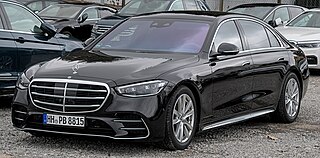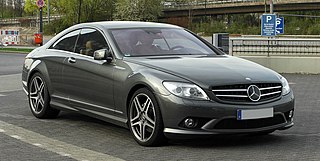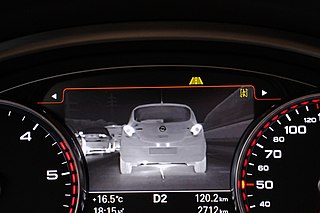Related Research Articles

The Mercedes-Benz S-Class, formerly known as Sonderklasse, is a series of full-sized luxury sedans, limousines and armored sedans produced by the German automaker Mercedes-Benz, a division of the German company Mercedes-Benz AG. The S-Class is the designation for top-of-the-line Mercedes-Benz models and was officially introduced in 1972 with the W116, and has remained in use ever since. The S-Class is the flagship vehicle for Mercedes-Benz.

Electronic stability control (ESC), also referred to as electronic stability program (ESP) or dynamic stability control (DSC), is a computerized technology that improves a vehicle's stability by detecting and reducing loss of traction (skidding). When ESC detects loss of steering control, it automatically applies the brakes to help steer the vehicle where the driver intends to go. Braking is automatically applied to wheels individually, such as the outer front wheel to counter oversteer, or the inner rear wheel to counter understeer. Some ESC systems also reduce engine power until control is regained. ESC does not improve a vehicle's cornering performance; instead, it helps reduce the chance of the driver losing control of the vehicle.

An advanced driver-assistance system (ADAS) is any of a groups of electronic technologies that assist drivers in driving and parking functions. Through a safe human-machine interface, ADAS increase car and road safety. ADAS use automated technology, such as sensors and cameras, to detect nearby obstacles or driver errors, and respond accordingly. ADAS can enable various levels of autonomous driving, depending on the features installed in the car.

In road-transport terminology, a lane departure warning system (LDWS) is a mechanism designed to warn the driver when the vehicle begins to move out of its lane on freeways and arterial roads. These systems are designed to minimize accidents by addressing the main causes of collisions: driver error, distractions and drowsiness. In 2009 the U.S. National Highway Traffic Safety Administration (NHTSA) began studying whether to mandate lane departure warning systems and frontal collision warning systems on automobiles.

The Mercedes-Benz W221 is a chassis code of S-Class, the successor of the Mercedes-Benz S-Class (W220) and the predecessor of the Mercedes-Benz S-Class (W222). The S-Class are the flagship vehicles of Mercedes-Benz and each generation typically introduces a range of technical innovations and developments that over time will find their way into smaller cars.
Mild hybrids are generally cars with an internal combustion engine equipped with an electric machine allowing the engine to be turned off whenever the car is coasting, braking, or stopped, and then quickly restarted once power is again required. Mild hybrids may employ regenerative braking and some level of power assist to the internal combustion engine (ICE), but mild hybrids do not have an electric-only mode of propulsion.

The W212 and S212 Mercedes-Benz E-Class series is the fourth-generation of the E-Class range of executive cars which was produced by Mercedes-Benz between 2009 and 2016 as the successor to the W211 E-Class. The body styles of the range are:

The Mercedes-Benz C216 is the last generation for the grand tourer with name Mercedes-Benz CL-Class. It replaced the C215 platform. In 2014 it was replaced by the C217 S-Class Coupe.
Brake assist or emergency brake assist (EBA) is a term for an automobile braking technology that increases braking pressure in an emergency. The first application was developed jointly by Daimler-Benz and TRW/LucasVarity. Research conducted in 1992 at the Mercedes-Benz driving simulator in Berlin revealed that more than 90% of drivers fail to brake with enough force when faced with an emergency.

Adaptive cruise control (ACC) is an available cruise control advanced driver-assistance system for road vehicles that automatically adjusts the vehicle speed to maintain a safe distance from vehicles ahead. As of 2019, it is also called by 20 unique names that describe that basic functionality. This is also known as Dynamic cruise control.

The driver monitoring system, also known as driver attention monitor, is a vehicle safety system to assess the driver's alertness and warn the driver if needed and eventually apply the brakes. It was first introduced by Toyota in 2006 for its and Lexus' latest models. It was first offered in Japan on the GS 450h. The system's functions co-operate with the pre-collision system (PCS). The system uses infrared sensors to monitor driver attentiveness. Specifically, the driver monitoring system includes a CCD camera placed on the steering column which tracks the face, via infrared LED detectors. If the driver is not paying attention to the road ahead and a dangerous situation is detected, the system will warn the driver by flashing lights, warning sounds. If no action is taken, the vehicle will apply the brakes. This system is said to be the first of its kind.

R231 is a chassis code for the sixth generation of the Mercedes-Benz SL-Class roadster, replacing the R230. The car was released in March 2012 and uses Mercedes-Benz's new 4.7 litre twin turbo V8 engine with a power output of 435 PS. AMG version of the roadster will follow. The new SL is 140 kg (309 lb) lighter than the previous, being made almost entirely out of aluminium. For the first time, the R231 SL-Class was not available with a non-AMG V12 engined SL 600 model.

A collision avoidance system (CAS), also known as a pre-crash system, forward collision warning system, or collision mitigation system, is an advanced driver-assistance system designed to prevent or reduce the severity of a collision. In its basic form, a forward collision warning system monitors a vehicle's speed, the speed of the vehicle in front of it, and the distance between the vehicles, so that it can provide a warning to the driver if the vehicles get too close, potentially helping to avoid a crash. Various technologies and sensors that are used include radar (all-weather) and sometimes laser (LIDAR) and cameras to detect an imminent crash. GPS sensors can detect fixed dangers such as approaching stop signs through a location database. Pedestrian detection can also be a feature of these types of systems.

An automotive night vision system uses a thermographic camera to increase a driver's perception and seeing distance in darkness or poor weather beyond the reach of the vehicle's headlights. Such systems are offered as optional equipment on certain premium vehicles. The technology was first introduced in the year 2000 on the Cadillac Deville. This technology is based on the night vision devices (NVD), which generally denotes any electronically enhanced optical devices operate in three modes: image enhancement, thermal imaging, and active illumination. The automotive night vision system is a combination of NVDs such as infrared cameras, GPS, Lidar, and Radar, among others to sense and detect objects.
Driver drowsiness detection is a car safety technology which helps prevent accidents caused by the driver getting drowsy. Various studies have suggested that around 20% of all road accidents are fatigue-related, up to 50% on certain roads.

The Mercedes-Benz CLA class is a series of luxury compact executive cars manufactured by Mercedes-Benz since 2013. The first generation was a four-door sedan based on the platform of the W176 A-Class and W246 B-Class compact cars, marketed as a four-door coupé. In 2015, Mercedes-Benz expanded the CLA family to include the Shooting Brake, a station wagon configuration. As the V177 A-Class sedan took its place as the budget-conscious sedan, the second generation got longer and wider than the W205 C-Class.
Wrong-way driver warning is a new advanced driver-assistance system introduced in 2010 to prevent wrong-way driving.

The Mercedes-Benz W205 is the fourth generation of the Mercedes-Benz C-Class which was produced by Daimler AG between 2014 and 2021. The W205 C-Class was preceded by the W204 C-Class and superseded by the W206 C-Class. The fourth-generation C-Class was available in sedan (W205), station wagon/estate (S205), coupe (C205), cabriolet (A205) and long-wheel sedan (V205) body styles.

In road-transport terminology, lane centering, also known as auto steer or autosteer, is an advanced driver-assistance system that keeps a road vehicle centered in the lane, relieving the driver of the task of steering. Lane centering is similar to lane departure warning and lane keeping assist, but rather than warn the driver, or bouncing the car away from the lane edge, it keeps the car centered in the lane. Together with adaptive cruise control (ACC), this feature may allow unassisted driving for some length of time. It is also part of automated lane keeping systems.
Pedestrian crash avoidance mitigation (PCAM) systems, also known as pedestrian protection or detection systems, use computer and artificial intelligence technology to recognize pedestrians and bicycles in an automobile's path to take action for safety. PCAM systems are often part of a pre-collision system available in several high end car manufacturers, such as Volvo and Mercedes and Lexus, and used less widely in lower end cars such as Ford and Nissan. As of 2018 using 2016 data, more than 6,000 pedestrians and 800 cyclists are killed every year in the US in car crashes. Effective systems deployed widely could save up to 50% of these lives. More than 270,000 pedestrians are killed every year in the world. An excellent analysis of technology capabilities and limitations is provided in Death of Elaine Herzberg. Pedestrian safety has traditionally taken a secondary role to passenger safety.
References
- ↑ "TOYOTA: News Releases". Archived from the original on 2016-10-27. Retrieved 2016-03-08. Toyota Adds to Pre-crash Safety Technologies
- ↑ http://www.toyota-global.com/innovation/safety_technology/safety_technology/img/Toyotas_history_of_safety_technology.pdf History of Safety Technology - Toyota
- ↑ http://www.motorauthority.com/news/1032400_toyota-upgrades-pre-crash-safety-suite-with-probable-accident-detection-radar-system Toyota upgrades Pre-crash Safety suite with ‘probable accident detection’ radar system
- ↑ "Car News and Information".
- ↑ http://techcenter.mercedes-benz.com/en/bas_plus_cross_traffic_assist/detail.html BAS PLUS with Cross-Traffic Assist